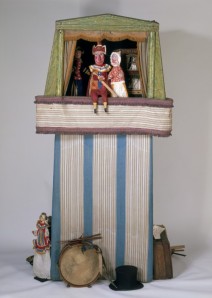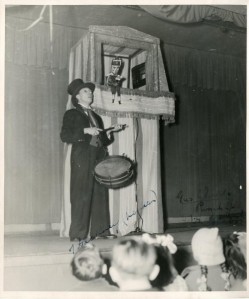A few weekends ago, Punch and Judy performers from across the country gathered in Covent Garden to celebrate the 350 year anniversary of the first recorded puppet show in Britain to feature Mr Punch. This summer at the V&A Museum of Childhood we are marking the milestone with a display showing the history of this rambunctious and controversial character.
Find out more about Happy Birthday, Mr Punch
But there’s another anniversary to mark. In the Museum’s Upper Galleries, visitors can see a Punch and Judy booth first used 100 years ago. It is tall and narrow, made of faded blue, yellow and white striped fabric, with columns each side of a stage painted to resemble marble.
Gus Wood, a Punch ‘professor’, performed in this booth for fifty years, and gave it to the Museum in 1968. This amazing donation also included pipes and a drum, a set of puppets, and the hangman’s noose, coffin and pall that were integral to Punch’s dark tale of murder and revenge. But I wondered if there was anything else we knew about Gus. Where did he perform? How old was he when he started?
In the archive file for the Punch and Judy booth there was a letter from Gus, dated May 1968, and two photographs. One showed a man standing proudly next to the booth. His left hand draws attention to the decorative tassels, and he has the shy smile of a man whose face isn’t often the centre of attention. The booth is recognisable from the Upper Galleries in the Museum. Helpfully it also has a banner attached, with Gus’s name and address on it: 31 Agincourt Road, Hampstead.
A bit of digging found out that Agincourt Road, in NW3, was a smart avenue of houses built in 1886 for the ‘lower end of middle-class respectability’.[1] Now, knowing his name and address, it was possible to sketch out a bit more of Gus’s life story.
The birth records for London show Augustus John Wood was born in St Pancras on 23 May 1892, the second son of a self-employed ‘waterproof sheet maker’. So when Gus started performing in this booth in 1912, he was 20 years old. However, officially he was following in his father’s footsteps. The 1911 census shows him being a ‘shop and window blind maker’, and when he joined up in 1916, his occupation was ‘canvas worker’. I like to imagine that Gus and his father made the Punch and Judy booth together, choosing a blue and white striped fabric that was their favourite from the jobs they had done for local butchers and bakers.
In the First World War Gus served in the Royal Naval Air Force, stationed with the ‘Pulham Pigs’ airships in Norfolk. The service records of the time recorded not only where men were stationed, but gave physical descriptions that help us to flesh out and colour in the records and photographs we have. Gus is described as being 5’7¾” tall, with a 34½” inch chest, blue eyes, brown hair, and “fresh complexion”.
Gus was twice married and twice widowed. His first wife was Jessie K. Chillestone, who he might have met at Pelham, as they married in Depade, Norfolk, in 1919. Jessie was only about 16 or 17 at the time, and sadly died after eight years of marriage. Then in 1929 Gus married Helen Brunton, who he would stay with until her death in 1972.
The fact that Gus isn’t officially recorded as a Punch and Judy performer anywhere underlines the fact that popular entertainments like puppetry are overlooked in the records of government. The seasonal, self-employed nature of the job meant that performers must have needed steady work too. This means that the oral histories of the performers, the material evidence of their work, marginal records like small ads, handbills and photographs in local papers, and the work of enthusiastic collectors, are essential in holding on to their history.
The photograph of Gus next to his ‘Up-to-date’ Punch and Judy banner was taken at some point before 1933. My hunch is that it comes from 1928, the same year Gus spent 5 shillings placing an advert in The Times, reading:
GUS WOOD. Punch and Judy, Clowns, &c. 31, Agincourt Road, Hampstead, NW3 0931, Hamp.[2]
In the 1930s Helen and Gus moved from north London to Hackney in the East, finding a house in Narford Road, Clapton.
The next source for Gus’s life throws up a few questions too. It is a picture of Gus performing to an audience of children, in an unknown venue. The booth is familiar, and the Punch puppet gleefully dangling his legs over the edge can now be seen in the Museum. When and where could this be? There is a stage and curtains, and judging by the ribbons in the girls’ hair, it is probably a special occasion.
On the right hand side of the photo, a handwritten annotation identifies the man with the drum:
Gus Wood’s Punch and Judy Show. With Bimbo.
Bimbo was Gus’s ‘bottler’. The role of the bottler was to bang the drum to raise the crowd, encourage the audience’s cheers and boos, and to collect the money. I wonder how long Gus and Bimbo were a partnership? The Museum now owns the drum that Bimbo is banging, so that must have belonged to Gus.
Diagonally across the bottom left hand side of the photo is another inscription:
Kind regards
G C Carter Mayor of Hackney (London)
1947/8/9
This suggests that Gus must have met the Mayor and asked him to sign this photograph. But why would George Carter sign a picture of Bimbo? My favourite interpretation is that Bimbo was the Mayor – but proving that point needs a bit more work! At any rate, the picture must have been signed after 1949, as Carter has added the dates that he held office, 1947-1949. It was unusual in Hackney’s history for the mayor to be elected for more than a year’s service, so this must have been worth adding to autographs.
The Hackney Gazette in 1947 reports plenty of occasions when children of the Borough had the opportunity to see Punch and Judy shows; they were provided free in the parks on summer weekends (along with big-bands and dancing for the adults). And on the occasional trips for ‘poor children’ that were paid for by subscription, the day at the zoo or seaside would inevitably include a Punch and Judy show along with the lemonade. But I am yet to find Gus’s name on the lists of performers at these popular public events.
The next picture we have of Gus isn’t in the Museum’s archives, but was sent to me by Geoffrey Felix, a Punch collector and author of ‘Conversations with Punch: Punch and Judy Men Talk About Their Lives’.
This beautiful photograph of Gus, aged 70, was taken in May 1962. Punch and Judy performers from across the country had descended on Covent Garden to mark 300 years since Samuel Pepys first saw Punch and wrote about it in his diary. At this event, like the anniversary this year, Punch professors brought their puppets together in celebration. The booth behind looks very much like Gus’s, so I wonder if, as a local performer, he brought that along too.
You can see video footage of the day here.
The Covent Garden celebration must have been a very significant day in Gus’s life, and in an inspired moment, he decided to pass round his drum to collect as many signatures as he could. The result is a fantastic snapshot of a generation of men from all over Britain: The London Punch professors were joined by more from Maidenhead, Liverpool, Southend, Worthing, Llandudno, Hartlepool, and Darlington amongst others.
1962 marked the end of Gus’s career as a Punch performer. Five years later he wrote to the Museum, offering his booth as a donation. Gus died in Hackney in 1975, aged 83. Finding out about Gus Wood has made me realise what an achievement it was to keep Punch and Judy going during fifty years that absolutely transformed the country. When he started, women couldn’t vote and the trams outside his house were pulled by horses. By 1962 British holiday makers were spending the summer on the Mediterranean and the Teddy Boys were bringing the velvet jackets and drain pipe trousers of Gus’s youth back into vogue! But Punch and Judy seem to have thrived, and continues to do so.
I will continue to look for Gus in the history of east London, and if you want to know more about Punch and Judy in Britain come and see Happy Birthday Mr Punch from 14 July.




My father might have seen Gus at the Whitestone Pond in Hampstead when my sister was a little girl in the eary 1930’s. He and my mother liked it so much that they made a fit-up and puppets, which he used on and off for some 40 years, mainly at private parties. I still have it all in my loft and hope that someone in the family will take a shine to it one day!
All the best,
John
Dear John,
It is highly likely that your father would have seen Gus at the Whitestone pond – My grandfather Cedric was one of his brothers (Gus, Cedric, Ted, and Les) and the family would have been living at No. 7 Warden Road in 1930 – quite close to Hampstead Heath where they all enjoyed spending time swimming and running.
Penelope Tompson (grand daughter of the late Cedric Wood brother of Gus)
Gus was my father and I helped him with his shows. Photo is of him showing Punch to my child Theresa his grand daughter. I was at that celebration.
Helen Macklin is my second Cousin and my Uncle Gus often showed me Punch and Judy at his home at 14 Narford Rd Croydon
Uncle Gus was married to my Grandmothers sister and visited us most years in Norfolk He would put his cycle on the train and visit relatives here. As a small child my Mother and I would stay a few days with the family in Narford Rd Uncle Gus would take me to see the sights of London an amazing experience for a little Norfolk girl He also would put on a Punch and Judy show for me I am still in touch with his Daughter my cousin Helen.
Hello Helen. I remember your Dad coming to visit at my Grandma’s house when we used to live with her in Burnt Oak in the 1950s. She was Rita Gallagher but I never knew how she knew your father. My Dad, Ken Gallagher (and his brother Bob I believe) helped Gus on the beach at Southsea(?) one time by collecting donations from the audience after the Punch and Judy show. In 1966 we had a tea party for Rita’s 80th birthday and I remember travelling with Dad to Clapton to collect your mother and bring her over as a surprise. I don’t recall Gus coming though.
Neil Gallagher